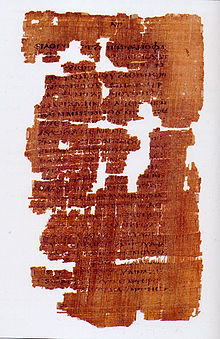Codex Tchacos
 |
Codex Tchacos is an
Codex Tchacos is important because it contains the first known surviving copy of the Gospel of Judas, a text that was rejected as heresy by the early Christian church and lost for 1700 years. The Gospel of Judas was mentioned and summarized by the Church Father
The Codex

The
Roughly a dozen pages of the original manuscript, seen briefly by scholars in the 1970s, are missing from the Codex today; it is believed that they were sold secretly to dealers, but none have come forward. According to National Geographic's website, fragments purported to be from the codex may also be part of an Ohio antiquities dealer's estate.
In April 2006, a complete translation of the text, with extensive footnotes, was released by the
April D. DeConick (the Isla Carroll and Percy E. Turner Professor of Biblical Studies in the Department of Religious Studies at Rice University) has published a book, The Thirteenth Apostle: What the Gospel of Judas Really Says, questioning both the National Geographic's handling of the Gospel of Judas' publication and the veracity of its translation. She has argued both that National Geographic denied competent scholars access and that the scholars who were granted access to the Codex Tchacos were not able to go about their work properly due to the constraints put upon them, accusations similar to those leveled at the guardians of the Dead Sea Scrolls. Most notably, she points out that the first National Geographic translation omitted a "not," reversing the meaning of the text. In an opinion piece in The New York Times (December 2, 2007), she wrote:
According to the National Geographic translation, Judas's ascent to the holy generation would be cursed. But it's clear from the transcription that the scholars altered the Coptic original, which eliminated a negative from the original sentence. In fact, the original states that Judas will "not ascend to the holy generation".[2]
The importance of the Codex Tchacos is not in doubt, but work has only begun in understanding its true influence and origin.
Notes
- ^ c. 180, Adv. Haer. 1.31.1.
- ^ DeConick, April D. (December 2, 2007). "What the Gospel of Judas really says". The New York Times. Retrieved June 27, 2021.
References
- J. Brankaer and H.-G. Bethge (eds), Codex Tchacos: Texte und Analysen (Berlin, Walter de Gruyter, 2007) (TU, 161).
External links
- Frequently Asked Questions, from National Geographic.
- The Coptic Ps. Gospel of Judas
- April D. DeConick, "Gospel Truth." The New York Times, December 1, 2007.
